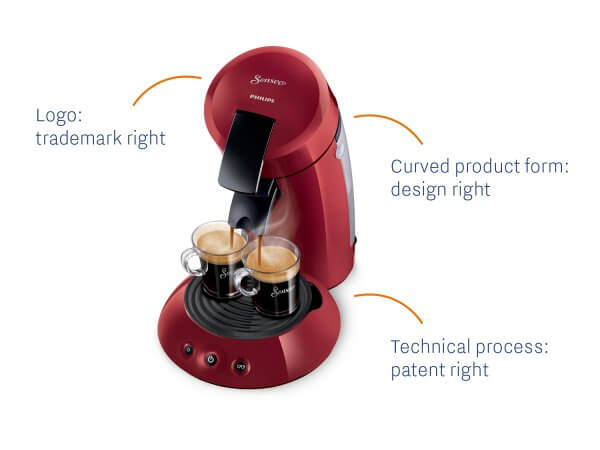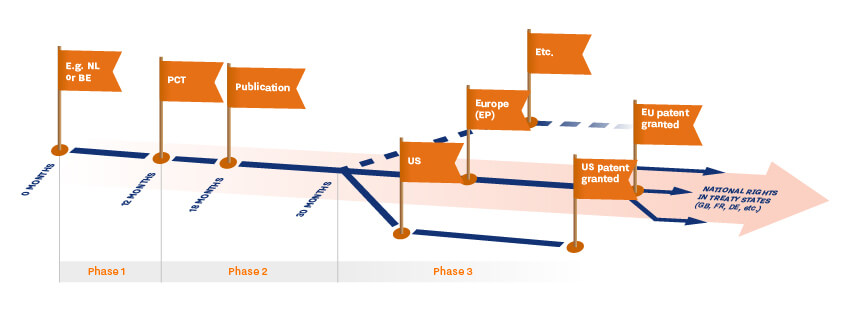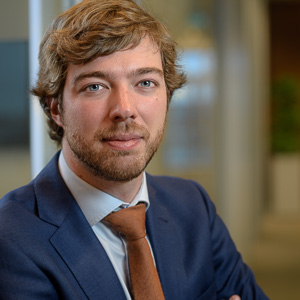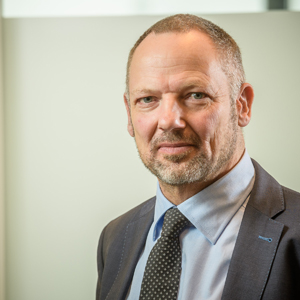As an entrepreneur, you want to meet market demand and stay ahead of the competition. Patents can play an important role in this. But what is a patent? Why should you patent? And what is needed to obtain a patent? On this page, we explain all the ins and outs around patents, so you can make your innovation more profitable.
Table of contents
- Types of intellectual property rights
- Non-disclosure or patent
- Objectives of patents
- Patent requirements
- Patent process
- What does a patent cost?
- FAQs
Types of intellectual property rights
There are various types of intellectual property rights (IP). The patent right protects the technical process or product of an invention for up to 20 years. It is an exclusive right: (without your permission) others are not allowed to manufacture, use, sell, rent, or supply your invention.
The trademark right protects trademarks registered in the trademark register. You can register various types of trademarks, such as a word or device mark, dimensional mark but also sounds and even fragrances can be a mark.
The design right can be used to protect the physical appearance (such as patterns and 3D shapes) of new and unique designs and products. Within the EU, it is possible to register the design up to 12 months after the first disclosure of the design.

Non-disclosure or patent?
In choosing between a patent and non-disclosure of your innovation, four things are important:
- Can you keep it secret? Sometimes non-disclosure is not possible, for example if the innovation is a paperclip with a particular shape that is obvious to everyone.
- Can it be copied? For example, Coca-Cola is highly successful at using non-disclosure to prevent the recipe from being reproduced.
- Is it patentable? The innovation must meet the requirements for patenting.
- Is the life cycle of the innovation long enough? It takes some time before the patent is granted. If the economic lifespan of the innovation is shorter than the time required to obtain the patent, patenting is not interesting - from an economic perspective - in most cases.
Objectives of patents
By dealing strategically with your intellectual property, you will strengthen your position and allow your innovation to yield optimal returns. It prevents others from using your technology; a patent offers protection against misuse by others. In addition, a patent not only strengthens your competitive position, it also makes you more appealing to partners and investors because it offers them additional security. Moreover, intellectual property enables you to generate added value through licenses or sales. This enables you to create security during a phase when it matters for your business.
Patent requirements
If you want to obtain a patent, then your invention must meet three requirements: novelty, inventiveness and industrial applicability.
Novelty:
This means that your invention was not disclosed anywhere in the world before the patent application was filed. Not even by you. The novelty requirement is generally not a major barrier and not all aspects of the invention must be new. A combination of familiar things or a smart choice could already bring novelty to your invention. If you have thought carefully about your invention, there is often already a new aspect to point out.
Inventiveness:
This means that your idea must not appear obvious. The question whether an invention is inventive is often judged on the basis of whether the invention improves on what is already known, for example, because it solves a problem for which the solution was not obvious to the
average craftsman. Suppose in a fictive world, chairs have always been made with exactly four legs and never less. But they have a problem because they wobble. You suddenly realize that you can solve the wobbling issue, not by adding an additional stabilization element, but by actually removing one of the legs. In this (fictive) world this could potentially be a patentable invention.
Industrial applicability:
This means that the invention must be made or applied for industrial or commercial purposes. This is generally a low barrier and almost all technical inventions that are commercially applicable meet this requirement.
Patent process
First, take a look at the video below where we explain the patent application process:
Patent procedures often seem complicated and expensive. The three-stage route outlined below appeals to many, as it allows us to defer costs and keep options open. It is the most common route to patent protection.
Phase 1 – Premier depot
The first step is the priority application, also called premier depot or first filing. In this phase, your patent attorney advises you about the application strategy, based on your objectives. He or she will then draw up the priority application based on your wishes. This is an important moment because it is decisive for your patent rights. The date on which the application is filed is called the priority date for the patent, which is valid for a maximum of 20 years. Anything published after this priority date will not affect the validity of your patent. You will receive a novelty report after about eight months. With your patent attorney, you discuss the following steps to strengthen your patent application.
The text of the priority application can be changed, but no additional content can be added.
Phase 2 – International phase
In any following application you can add substantive content, that must be filed no later than 12 months after the priority date. This is often an international application, also called PCT (Patent Cooperation Treaty) application. You can add a new implementation, example, or even a new idea to this. A separate, and therefore later, priority date applies to these additions. Unlike the name suggests, an international application does not result in an international patent, but it does provide the possibility to eventually establish patent rights in almost all countries in the world. It is also a way in which to buy more time and delay costs because you do not have to immediately decide which countries you want the
patent in. The application and novelty report are published after 18 months.
Phase 3 – National / regional phase
You must choose the countries you want a patent in no later than two-and-a-half years after the priority date. Our patent attorney will advise you when making this choice. Do you want a patent in several European countries? Then a European patent application could be a good choice. The European Patent Office will examine the novelty, inventive step, and industrial applicability of your invention.
In this phase, your patent attorney often consults with this organization in order to guide your application through the process as smoothly as possible. A European patent is issued after two years on average. That is followed by validation in the countries themselves, after which you pay an annual maintenance fee per country.

What does a patent cost?
On average it costs about €8,000 to obtain a patent in the Netherlands and Belgium and €14,000 in Germany. A patent attorney will develop the application strategy for this based on your objectives and draft and file the patent application. The final amount depends on your objectives and the complexity of your invention. Do you want a patent in several European countries? If so, then generally you file an application for a European patent and the granted patent is subsequently validated per country. This is often cheaper than separate granting procedures per country.
A European patent granting procedure costs an average of about €20,000 until it being granted, after which the validation fees are an average of about €1,000 per country (global estimates). In countries outside of Europe, the costs for obtaining and maintaining a patent can vary considerably. This has to do with translation requirements, lengths of procedures and complexity of the invention, among other things. You also pay maintenance fees to maintain your patent rights.


